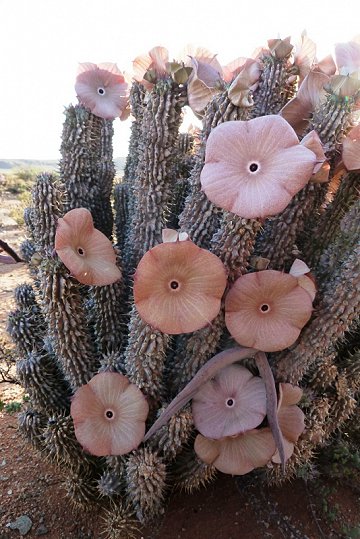
|
|
Hoodia - Bushman's hat
(Hoodia gordonii).
|
Hoodia - Bushman's hat -
Hoodia gordonii
Hoodia gordonii, also known as Bushman's hat, is a leafless spiny succulent plant
of Apocynaceae family supposed to have therapeutic properties in folk
medicine. It grows naturally in Botswana, South Africa and Namibia. The species became internationally known and threatened by
collectors, after a marketing campaign falsely claimed that it was an appetite suppressant for weight
loss.
It grows naturally in a very wide area of the Kalahari desert in South Africa and
Namibia. It is also found in the deserts of Botswana and Angola. Grows in winter-rainfall regions in deep Kalahari
sands, on dry stony slopes or flats often under the protection of xerophytic bushes but it has a wide tolerance of growing
habitats. In places where the temperature soars past 50°C , but it can survive in relatively low temperatures (-3°C). This area is home to a wide range of unique plant
species.
Hoodia gordonii is a leafless fat-stemmed and spiny succulent plant similar to a
cactus. In the early stages only one stem is produced but at a later stage the plant produces clusters of green upright
stem. Mature plants can have as many as 50 individual branches and weigh as much as 30
kg. Plants under ideal conditions can attain a height of 1 m. Hoodia gordonii can under ideal conditions live for 25 years in
cultivation. In the wild they probably don't live much longer than 15 years.
Stem is greysh-green to pale brown, stricltly
cylindrical, 2,5-5 in diameter. The knobbly surface helps to scatter the sun's
radiation, minimising the amount of heat they absorb. Tubercles rotruding, blunt, arranged in 11-17
rbs. Apically with an acute spine 6-12 mm long.
Flower óé óaucer-shaped, strictly 5-lobed with a central depression, large up to 75
mm, pale straw, pale purple to dark maroon colored and usually with darker venation
(vaguely resembleing a petunia flower) borne on or near the terminal apex (top part of the
plant), inflorescence very shortly pedunculate, with group of 1-4 flowers. The flowers smell like rotten meat and are pollinated mainly by
flies.
Flowers are normally borne in August or September. Hoodia takes duration of 5 years to be completely
mature, till its flowers appear.
Fruits are capsules. The seed capsules resemble small antelope or goat
horns.
The seeds are light brown in colour, are flat and have a pappus of fluffy hair attached to their one
end. This pappus acts as a parachute when the seed pod splits open. The seeds are blown some distance from the parent plant where they will establish
themselves.
Hoodia gordonii has long been known by the indigenous populations of Southern Africa that have been using it for centuries to stave off hunger during their long and arduous hunting trips in the harsh South African wild and also for treating indigestion and small
infections.
It wasn’t until the turn of the century that anthropologists noted hoodia being eaten by the
San, or African bushmen. The San use hoodia for a variety of medicinal purposes, but most
often, they chew it to avoid getting hungry and thirsty during extended hunting
trips. There are twenty different species of hoodia, but only hoodia gordonii appears to have the active ingredient p57, which provides the effects of an appetite
suppressant.
The genus became internationally known and threatened by collectors, after a marketing campaign falsely claimed that it was an appetite suppressant for weight
loss.
The South African government gained a patent for p57 and licensed it to a pharmaceutical
company, Phytopharm. Later, it was determined that hoodia was not economically feasible for mass
production, particularly due to the inability to effectively grow it anywhere except the African
desert.
Nowadays Hoodia is used as a component in diet pills that leads to the purpose of weight loss and is remarkably wanted in developed
countries.
Source:
https://en.wikipedia.org/wiki/Hoodia_gordonii
https://www.everydayhealth.com/healthy-living/
alternative-health/hoodia-dangers-how-dangerous-hoodia/
http://www.cactus-art.biz/schede/HOODIA/
Hoodia_gordonii/Hoodia_gordonii/Hoodia_gordonii.htm
